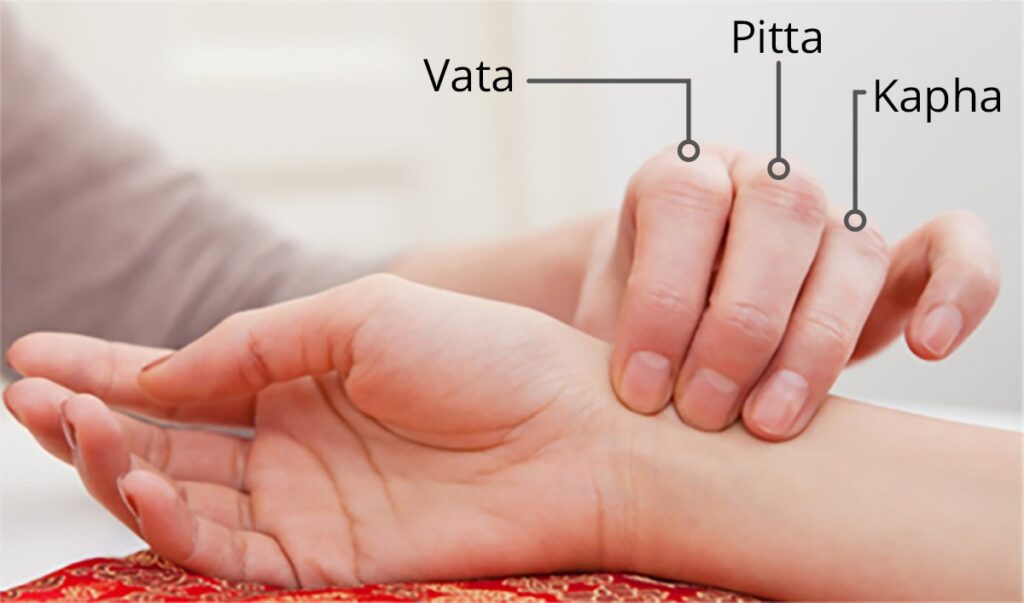Nadi analysis – Pathway Towards Diagnosis.

Nadi Pariksha, or pulse diagnosis, is a fascinating and complex aspect of Ayurveda medicine, rooted in ancient traditions and texts like Yog Ratnakar, Bhav Prakash, and Sharangdhar Samhita. The practice involves assessing the pulse to gain insights into an individual’s health, including physical, physiological, and psychological states.
Here’s a broad overview of how Nadi Pariksha is understood to work and its relevance to diagnosing imbalances in the body and mind:
1. Pulse as a Reflection of Health: According to Ayurveda, the pulse (Nadi) is a reflection of the body’s internal state. It is believed that the pulse carries information about the balance of the three doshas (Vata, Pitta, and Kapha), the state of the organs, and overall vitality.

2. Types of Pulses: Traditionally, practitioners identify three main types of pulses that correspond to the three doshas:
आदौ च वहते वातो मध्ये पित्तम तथैव च !
अन्ते वाहते श्लेष्मा नाडिका त्रय लक्षणं !! रावण कृत नाडी
- Vata Pulse: Typically characterized by a light, irregular, and sometimes rapid beat.
- Pitta Pulse: Usually more intense, warm, and regular, with a moderate to fast rhythm.
- Kapha Pulse: Generally slow, steady, and heavy, reflecting stability and calm.
3. Pulse Diagnosis Techniques: Practitioners use their fingers to palpate different points on the wrist, each associated with specific organ systems and doshas. By feeling the pulse in various positions and depths, they assess the qualities and rhythms that reveal imbalances.
Imbalances in Organ Systems and Mind.
1. Physical Imbalances: Sharir vikruti
- Digestive Issues: Changes in the pulse can indicate problems with digestion or metabolism. For instance, an irregular or weak pulse might suggest digestive disturbances or low metabolic fire.
- Cardiovascular Health: Cardiovascular Health A pulse that is erratic or weak can point to issues with heart function or blood circulation.
2. Physiological Imbalances: Sharir kriya vikruti
- Hormonal Changes: Variations in pulse rhythm and strength can reflect hormonal imbalances. For example, a rapid pulse may be associated with conditions like hyperthyroidism.
- Immune System: The pulse might also reveal the state of the immune system, showing signs of infection or inflammation.
3. Psychological Imbalances: Manas
- Stress and Anxiety: A pulse that is erratic or overly rapid might suggest mental stress or anxiety. The characteristics of the pulse can help identify whether these psychological states are due to excess Vata or Pitta.
- Emotional Well-being: Persistent emotional issues can manifest in the pulse as well, potentially leading to an understanding of the underlying emotional state and its impact on overall health.
In essence, Nadi Pariksha offers a unique lens through which to understand and diagnose health conditions, drawing on a rich tradition of Ayurvedic knowledge. It continues to be a valuable tool for those who appreciate its depth and historical context.
The Nadi Tarangini device is an innovative tool that bridges traditional Ayurvedic wisdom with modern technology, providing a comprehensive 22-page report card. This report card offers detailed insights into various Ayurvedic parameters, highlighting their ranges and potential associated symptoms. Designed to support Ayurvedic practitioners in their daily practice, the device enhances diagnostic precision by offering quantifiable data rooted in ancient principles. In this white paper, we delve into the methodology behind the computation of these parameter ranges, offering a thorough explanation of the processes and algorithms that underpin the device’s functionality. This document aims to provide clarity on how the Nadi Tarangini device integrates the rich heritage of Ayurveda with contemporary analytical techniques, ensuring that practitioners can confidently utilize this tool in their pursuit of holistic health.

The parameters which are examined through nadi pariksha as per ancient text, clinical practice are coming through nadi Trangini report card. We study, analyse and come to the diagnosis part.
The vata, pitta and kapha analysis regarding its gati, guna which are discussed below.
1. Sama / Nirama nadi:
Aam(आम) is undigested food. The root cause of all diseases is “Aama.” When the digestive fire (जठराग्नी) is in a state of low or irregular intensity, “Aama” is formed. When “Aama” is in the stomach, symptoms like heaviness, lack of taste, aversion to food, laziness, and excessive sleep are observed. When the nadi is filled with Aama, it becomes heavy or guru, manda or slow moving. In the absence of Aama, the nadi is nirama which is laghu or light, and fast moving.
In Nadi Tarangini pulse report, we check amplitude, force, frequency, quantity, shape and volume properties of the time series to conclude if the pulse is Sama or Nirama.
2. Manda/ Vegavati nadi:
When the pulse is slow and the pulse rate is low, it is called a slow or Manda (मंद) pulse. The pulse is usually slow in conditions of heaviness, obesity, Sama (imbalance), Kapha aggravation, and weak digestive fire. A fast pulse is called a rapid pulse (वेगवती). The pulse is usually rapid in conditions of Vata aggravation, lightness, subtlety, a balanced state, and strong digestive fire.
3. Gati based Nadi Vikruti:
Nadi as per movement of sarpa, Manduka, and Hansa gati:
वातोद्रके गतिं कुर्यात जलौका सर्पयोरिव |
पित्तोद्रके तु सा नाडी काकमंडूक योगरतीम |
हंसस्येव कफोद्रके गतिं परावतस्य वा |
(रावण कृत नाडी)
The movement of vata nadi resembles snake or leech, pitta with frog or crow and kapha with swan or pigeon.
In Nadi Tarangini pulse report, we check frequency, rhythm, speed and shape properties of the time series to conclude if the pulse is Manda or Vegavati.
4. Bala:
While checking the pulse, the pressure exerted back on the finger (once it is pressed) is called Bala. The strength of a disease is determined by the characteristics and movement of Vata, Pitta, and Kapha doshas in the pulse. Usually when the pulse is hard, thick, heavy, and slow, the disease strength is greater. Nadi bala or strength can be प्रवर (excellent) – mentally and physically active, मध्य (moderate) or अवरा (weak) – tired.
In Nadi Tarangini pulse report, we check depth, intensity, length, type or shape, quantity, texture and volume properties of the time series to compute the level of Bala.
5. Jatharagni:
In our report, we have considered Jatharagni, one of the types of Agni – Samana Vayu and digestive Pitta function at the site of Agni (digestive fire). The organ ‘Grahani’ is the seat of Agni. Agni has the qualities of heat, sharpness, and lightness. When examining Agni through the pulse, if the pulse is sharp, light, and fast, it indicates that Agni is strong; otherwise, a slow, heavy, and thick pulse indicates weak digestive fire (Mandagni).
In Nadi Tarangini pulse report, we check depth, intensity, length, type or shape, quantity, texture and volume properties of the time series to compute the level of Agni.
With Nadi tarangini now you can experience the insights of providing, mandagni, tikshagni and samagni features with a predictive etiology.
As studied in population, and from ancient text, mandagni found in kapha prakruti and as an imbalanced state denotes loss of appetite, anorexia, tastelessness, laziness, heaviness as a vikruti.
Tikshagni is the feature of Pitta predominant prakruti, middle age population. As seen in clinical practice and from ancient text references , tikshnagni shows hyperacidity, acne, burning in chest, stomach and abdomen, graying of hair, excess hunger, migraine, skin rashes, pitta disorders.
6. Guna: Laghu-Guru:
The Guru quality is primarily associated with the earth (Prithvi) and water (Jal) elements, which contribute to increasing strength, nourishing muscles, and enhancing all body tissues.
In the pulse, the Guru quality is found in conditions like Kapha dominance, accumulation of Aam(undigested food), indigestion, obesity, diabetes, and various other disorders. The pulse that feels thick, heavy, and slow under the fingers is considered a Guru (heavy) pulse.
Laghu (Light) means something that is light in weight and is primarily associated with the elements of ether (Akash), air (Vayu), and fire (Agni). Laghu is a quality predominantly related to the Vata dosha. It usually increases digestive fire (Agni), promotes lightness in the body, and can lead to the aggravation of Vata. When the pulse feels quick and light, it is considered a Laghu (light) pulse.
In Nadi Tarangini pulse report, we check depth, intensity, length, type or shape, quantity, texture and volume properties of the time series to conclude if the pulse is Laghu or Guru
Laghu nadi observes in nirama state, proper hunger, pitta in balance. Lagu guna on the higher side is vegavati nadi under pitta and vata sites, denotes vata prakop or vata aggravation, anxiety, stress, joint pain, bloating, loer back pain like conditions.
Guru nadi observes in sama state, excess kapha accumulation, conditions like obesity, medorog, inflammation, joint swelling, laziness, excess of sleep like vikruti.
7. Guna: Sthula-Sukshma:
Sthula (Heavy/Thick) means something that is full or bulky. Obstruction in the body channels (Srotas) occurs due to the Sthula quality. This quality is primarily associated with the earth (Prithvi) element. It leads to the increase of Kapha and Aam(undigested food). In nadi parikshan, a Sthula pulse feels thick and full to the touch, and can be felt superficially.
Sukshma (Subtle) means something very fine and imperceptible. The Sukshma quality is primarily associated with the elements of fire (Agni), air (Vayu), and ether (Akash). It increases Vata and pacifies Kapha. A Sukshma pulse is very deep, imperceptible, and thread-like. It is subtle, thin and felt deeply with more pressure.
In Nadi Tarangini pulse report, we check intensity, type or shape, volume, frequency and speed properties of the time series to conclude if the pulse is Sthula or Sukshma.
While doing nadi analysis, one should corelate the guna with each other if they are likewise. Sthula is guna of kapha, so when sthula nadi observed kapha aggravation, aam, mansa vruddhi, asthivruddhi. When pitta is associated with skin disorder like herpes may come in picture.
Sukshma nadi is found in chronic diseases. Its prognosis comes from kashtasadhya. Vata imbalances, vata prakop , prameha vikruti has sukshama nadi.
8. Guna: Tikshna-Manda:
Tikshna (Sharp) is a quality primarily associated with the fire (Agni) element. It helps in the reduction of muscle tissue (Mamsa Dhatu). Tikshna quality increases Agni and causes the aggravation of Pitta. When the pulse feels sharp and strong, it indicates an increase in Tikshna Tikshna quality. During Nadi parikshan, the feeling is sharp with prominent pulsation.
The Manda (Slow) quality is primarily associated with the earth (Prithvi) and water (Jal) elements. Manda means something that moves slowly and has a pacifying action. It promotes the growth of muscle (Mamsa) and fat (Meda) tissues. In the pulse, a slow-moving, gradual pulse is considered a Manda (slow) pulse.
In Nadi Tarangini pulse report, we check amplitude, length, texture, type or shape and rhythm properties of the time series to conclude if the pulse is Tikshna or Manda.
Tikshna is guna of pitta dosha, considering the same, tikshnata in nadi goes towards amlapitta, skin disorders, migraine. When sthulata comes together with tikshnata may goes towards hypertension, heart diseases.
9. Guna: Kathina-Mrudu:
The Kathina (Hard) quality is primarily associated with the earth (Prithvi) element. It provides firmness and roughness to the body. During nadi parikshan, a Kathina pulse feels firm and hard to the touch. When the nadi is pressed hard and still couldn’t press it easily is the Kathana nadi.
The chronic disorders and which has deep rooted pathology in diseases like heart diseases, rakatavaha srotas complaints nadi founds Kathin.
The Mrudu (Soft) quality creates softness in the body. It is a Kapha- -enhancing quality.
It pacifies Vata and Pitta. A Mrudu pulse feels soft & elastic to the touch and stops blood flow when pressed.
In Nadi Tarangini pulse report, we check depth, intensity, force, type or shape, quantity, texture and volume properties of the time series to conclude if the pulse is Kathina or Mrudu.
10. Guna: Singdha-Ruksha:
The Snigdha (Oily) quality creates moisture, softness, and oiliness in the body. It pacifies Vata and Pitta while enhancing Kapha. Strength, complexion, and nourishment of body tissues are promoted by the Snigdha quality. During nadi parikshan, a Snigdha pulse feels soft yet strong to the touch.
The Ruksha (Dry) quality creates dryness in the body. It aggravates Vata and pacifies Kapha. This quality is primarily associated with the air (Vayu) and earth (Prithvi) elements. A Ruksha pulse feels hard and rough to the touch.
In Nadi Tarangini pulse report, we check intensity, length, type or shape, quantity, texture and volume properties of the time series to conclude if the pulse is Snigdha or Ruksha
Considering all these parameters, correlating them with each other, gati and guna comes diagnosis through nadi pariksha.
Author- Vaidya Tejaswini Sameer Bhale
Ayurvedacharya, PGPP, MBA, DYA
Prakruti Ayurveda and Panchakarma Clinic, Pune
Nadi Pariksha domain expertise
Nadi Tarangini, Atreya Innovations Pvt Ltd. Pune
For regular updates, like and follow:

